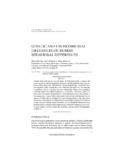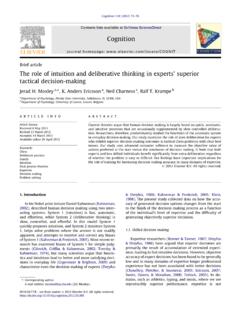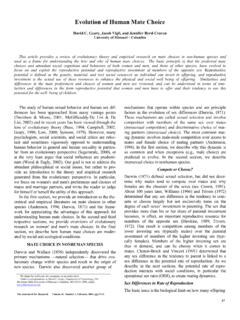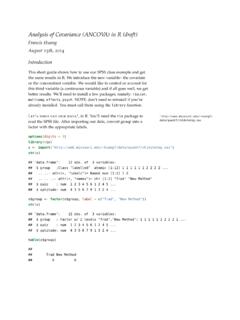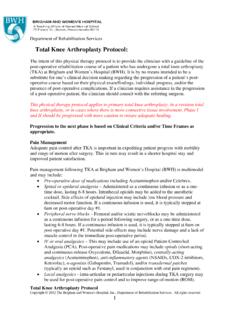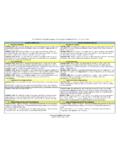Transcription of Choices, Values, and Frames - University of Missouri
1 1983 APA Award AddressesChoices, Values, and FramesDaniel Kahneman University of British ColumbiaAmos Tversky Stanford UniversityABSTRACT: We discuss the cognitive and the psy-chophysical determinants of choice in risky and risk-less contexts. The psychophysics of value induce riskaversion in the domain of gains and risk seeking inthe domain of losses. The psychophysics of chanceinduce overweighting of sure things and of improbableevents, relative to events of moderate probability.
2 De-cision problems can be described or framed in multipleways that give rise to different preferences, contraryto the invariance criterion of rational choice . The pro-cess of mental accounting, in which people organizethe outcomes of transactions, explains some anomaliesof consumer behavior. In particular, the acceptabilityof an option can depend on whether a negative outcomeis evaluated as a cost or as an uncompensated relation between decision values and experiencevalues is decisions is like speaking prose people doit all the time, knowingly or unknowingly.
3 It is hardlysurprising, then, that the topic of decision making isshared by many disciplines, from mathematics andstatistics, through economics and political science, tosociology and psychology. The study of decisions ad-dresses both normative and descriptive questions. Thenormative analysis is concerned with the nature ofrationality and the logic of decision making. The de-scriptive analysis, in contrast, is concerned with peo-ple's beliefs and preferences as they are, not as theyshould be.
4 The tension between normative and de-scriptive considerations characterizes much of thestudy of judgment and of decision making commonly distin-guish risky and riskless choices. The paradigmaticexample of decision under risk is the acceptability ofa gamble that yields monetary outcomes with specifiedprobabilities. A typical riskless decision concerns theacceptability of a transaction in which a good or aservice is exchanged for money or labor. In the firstpart of this article we present an analysis of the cog-nitive and psychophysical factors that determine thevalue of risky prospects.
5 In the second part we extendthis analysis to transactions and ChoiceRisky choices, such as whether or not to take anumbrella and whether or not to go to war, are madewithout advance knowledge of their the consequences of such actions depend onuncertain events such as the weather or the opponent'sresolve, the choice of an act may be construed as theacceptance of a gamble that can yield various out-comes with different probabilities. It is therefore nat-ural that the study of decision making under risk hasfocused on choices between simple gambles withmonetary outcomes and specified probabilities.
6 In thehope that these simple problems will reveal basic at-titudes toward risk and shall sketch an approach to risky choice thatderives many of its hypotheses from a psychophysicalanalysis of responses to money and to psychophysical approach to decision making canbe traced to a remarkable essay that Daniel Bernoullipublished in 1738 (Bernoulli 1738/1954) in whichhe attempted to explain why people are generallyaverse to risk and why risk aversion decreases withincreasing wealth.
7 To illustrate risk aversion and Ber-noulli's analysis, consider the choice between a pros-pect that offers an 85% chance to win $1000 (with a15% chance to win nothing) and the alternative ofreceiving $800 for sure. A large majority of peopleprefer the sure thing over the gamble, although thegamble has higher (mathematical) expectation. Theexpectation of a monetary gamble is a weighted av-erage, where each possible outcome is weighted byits probability of occurrence.
8 The expectation of thegamble in this example is .85 X $1000 + .15 X$0 = $850, which exceeds the expectation of $800associated with the sure thing. The preference for thesure gain is an instance of risk aversion. In general,a preference for a sure outcome over a gamble thathas higher or equal expectation is called risk averse,and the rejection of a sure thing in favor of a gambleof lower or equal expectation is called risk suggested that people do not evaluateprospects by the expectation of their monetary out-comes, but rather by the expectation of the subjectiveApril 1984 American PsychologistCopyright 1984 by the American Psychological Association, 39, No.
9 4, 341-350341value of these outcomes. The subjective value of agamble is again a weighted average, but now it is thesubjective value of each outcome that is weighted byits probability. To explain risk aversion within thisframework, Bernoulli proposed that subjective value ,or utility, is a concave function of money. In such afunction, the difference between the utilities of $200and $ 100, for example, is greater than the utility dif-ference between $1,200 and $1,100. It follows fromconcavity that the subjective value attached to a gainof $800 is more than 80% of the value of a gain of$1,000.
10 Consequently, the concavity of the utilityfunction entails a risk averse preference for a suregain of $800 over an 80% chance to win $1,000,although the two prospects have the same is customary in decision analysis to describethe outcomes of decisions in terms of total example, an offer to bet $20 on the toss of a faircoin is represented as a choice between an individual'scurrent wealth W and an even chance to move toW + $20 or to W $20. This representation appearspsychologically unrealistic: People do not normallythink of relatively small outcomes in terms of statesof wealth but rather in terms of gains, losses, andneutral outcomes (such as the maintenance of thestatus quo).
